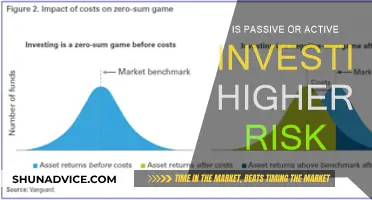
Investment portfolios are often updated to reflect an individual's risk profile and long-term investment goals. The ratio of stocks to bonds in a portfolio is directly related to risk and reward, with a higher percentage of stocks increasing the risk and potential returns. As a result, younger investors tend to opt for a more aggressive mix of stocks and bonds, while those closer to retirement may prefer a more conservative approach. Life events such as marriage, divorce, job changes, and health issues can also trigger a re-evaluation of one's investment portfolio. Additionally, market volatility and economic conditions may prompt adjustments to ensure the portfolio aligns with the investor's risk tolerance and financial objectives. While there is no one-size-fits-all approach, regular reviews and updates are essential to ensure the portfolio remains current and aligned with the individual's needs.
| Characteristics | Values |
|---|---|
| Risk tolerance | As you get older, you will likely want to take on less risk. |
| Time horizon | If you have more or less time until retirement, you may want to adjust your portfolio accordingly. |
| Life events | Marriage, divorce, a change in health, inheritance, etc. may all be reasons to update your portfolio. |
| Market conditions | While it's generally not a good idea to tweak your portfolio in response to market conditions, you may want to consider doing so if there is a severe downturn. |
| Financial goals | If your financial goals change, you may need to update your portfolio to reflect this. |
What You'll Learn

To reflect changes in your risk tolerance
Updating your investment portfolio to reflect changes in your risk tolerance is essential for several reasons. Firstly, your risk tolerance is likely to change over time as your circumstances evolve. For example, younger investors are typically more willing to take on risk, opting for a higher percentage of stocks in their portfolio. However, as one approaches retirement, a more conservative approach with a larger proportion of bonds may be preferable to reduce the risk of losses.
Secondly, your risk tolerance is influenced by various factors, including your investment goals, age, income, and future earning capacity. As your life stage changes, your risk appetite may also shift. For instance, if you are investing for retirement, you may have a longer time horizon and thus be more inclined to invest in higher-risk assets. In contrast, shorter-term financial goals may warrant lower-risk investments.
Additionally, significant life events can trigger a reevaluation of your risk tolerance. This includes events such as marriage, divorce, job changes, or an unexpected windfall. These events can alter your financial situation and priorities, necessitating adjustments to your investment portfolio.
Furthermore, it is crucial to understand the relationship between risk tolerance and asset allocation. A higher risk tolerance often leads to investing in stocks, equity funds, and exchange-traded funds (ETFs), while a lower risk tolerance may result in investing in bonds, bond funds, income funds, or guaranteed and highly liquid assets.
Finally, reviewing your risk tolerance annually or semi-annually is advisable to ensure your investment portfolio remains aligned with your current circumstances, goals, and life stage. This proactive approach allows you to make necessary adjustments and avoid unwanted outcomes.
In summary, updating your investment portfolio to reflect changes in your risk tolerance is crucial as it helps you make informed decisions, strike a balance between risk and reward, and ultimately achieve your financial objectives.
Global Investment Factors: What Doesn't Affect International Portfolios?
You may want to see also

To align with your long-term goals
Updating your investment portfolio to align with your long-term goals is a crucial aspect of financial planning. Here are some detailed paragraphs explaining this concept:
The Importance of Long-Term Goals
Long-term goals serve as the foundation of your investment journey. Whether it's saving for retirement, funding your child's education, or purchasing a home, having clear long-term goals provides direction and purpose to your investments. These goals guide the strategies you employ, the risk you're willing to take, and the allocation of your assets. By updating your portfolio to align with these goals, you can ensure that your investments are working towards your desired future outcomes.
Risk Tolerance and Time Horizons
Risk tolerance is a critical factor in investment decision-making. As your long-term goals evolve, your tolerance for risk may also change. For example, if you extend your retirement timeline, you may be comfortable taking on more risk by investing in aggressive, high-risk funds. Conversely, if retirement is approaching sooner than expected, you may need to reduce risk by shifting to more conservative investments. Updating your portfolio helps you adjust your risk exposure accordingly.
Regular Reviews and Adjustments
Frequent reviews of your investment portfolio are essential to staying aligned with your long-term goals. Life events, market fluctuations, and economic conditions can impact your goals and risk tolerance over time. By conducting regular reviews, you can identify when updates are necessary. Financial advisors often recommend annual or semi-annual reviews, but the frequency can vary based on your specific circumstances and the overall economic climate.
Rebalancing Your Portfolio
Over time, the performance of different assets in your portfolio can cause deviations from your intended asset allocation. For example, if you initially allocated 60% of your portfolio to equities and 40% to bonds, a significant rise in stock prices might increase your equity allocation to 70%. Updating your portfolio through rebalancing involves selling some of the outperforming assets (in this case, equities) to return to your original allocation. This helps maintain the appropriate level of risk and ensures your investments remain aligned with your long-term goals.
Utilizing Tools and Advisors
To effectively update your portfolio in line with your long-term goals, consider utilizing tools like robo-advisors or seeking guidance from financial advisors. Robo-advisors use questionnaires to understand your investment goals and automatically rebalance your portfolio as needed. Financial advisors, on the other hand, offer personalized advice and strategies tailored to your unique circumstances and goals. They can help you navigate complex decisions and ensure your portfolio remains aligned with your long-term objectives.
Robinhood Investing: Diversifying Your Portfolio for Beginners
You may want to see also

To adjust for market volatility
Volatile assets are generally riskier than those that experience less deviation from the mean. As such, investors should be prepared to adjust their investment portfolios to account for market volatility.
Diversification
One of the simplest and most important ways to control volatility is through diversification. Diversification helps to protect your portfolio by spreading out the risk. For example, a portfolio with a mix of different asset types and investment vehicles helps to limit being overexposed to any one sector or commodity.
Volatility indices
Volatility is a tool used by investors to determine price fluctuation from a historical mean. Broad-based volatility is measured by the Volatility Index (VIX). A higher VIX means that volatility is high, and the market could experience significant price movements. A lower VIX means the opposite.
Hedging
Hedging involves initiating short positions against long positions. For example, if you're holding 100 shares of a stock but believe the market is ripe for a correction, you could short-sell 100 shares of a high beta, overvalued stock that would fall at a higher rate than the overall market if a correction occurred.
Timing the market
Timing the market is difficult, especially with individual securities. However, in a diversified portfolio, a mix of different asset types and investment vehicles can help to limit being overexposed to any one sector or commodity.
Dividend investing
Although less popular than broad diversification, dividend investing can be used as an additional safeguard for volatility. When you invest in dividends, portfolio fluctuation decreases as dividend-issuing securities pose somewhat more predictable returns.
Cash allocation
The easiest way to reduce volatility in your portfolio is to sit out. Selling your positions and going to a higher allocation of cash completely shields you from short-term market fluctuations. Staying in cash for long periods isn't advised, but for traders who believe the market will soon stabilise, cash is an easy way to mitigate losses.
Explore Saving and Investment Options for Your Future
You may want to see also

To rebalance asset allocation
Understanding Rebalancing
Rebalancing your portfolio involves selling certain investments and using the proceeds to buy others to achieve your desired asset allocation. For example, if your original portfolio had 70% stocks and 30% bonds, but due to market fluctuations, it has shifted to 80% stocks and 20% bonds, you would sell a portion of your stocks and use that money to buy bonds to return to your target allocation. This process helps maintain your desired level of risk and return potential.
Determining Your Ideal Portfolio Mix
Before rebalancing, it is crucial to determine your ideal portfolio mix based on your risk tolerance and investment goals. Consider your age, financial goals, and how much risk you are comfortable taking. A common rule of thumb is to subtract your age from 110 to determine the percentage of your portfolio allocated to stocks, with the remainder in bonds. However, this may vary depending on your individual circumstances and risk tolerance.
When to Rebalance
There are different approaches to deciding when to rebalance your portfolio. One approach is to rebalance at specific time intervals, such as annually or quarterly. Another approach is to rebalance only when your portfolio deviates from your target allocation by a certain threshold, such as 5% or 10%. You can also combine these methods, rebalancing at specific intervals if your portfolio deviates by a certain amount.
Methods of Rebalancing
There are a few methods for rebalancing your portfolio. One is to sell existing investments and use the proceeds to buy others to achieve your desired allocation. Another method is to allocate new money strategically by investing new deposits into underweighted investments until your portfolio is balanced again. Additionally, if you use a robo-advisor or an employer-sponsored retirement plan, your portfolio may rebalance automatically.
Benefits of Rebalancing
Rebalancing your portfolio offers several benefits. Firstly, it helps you maintain your desired level of risk by ensuring your portfolio doesn't become too heavily weighted towards stocks or bonds. Secondly, rebalancing forces you to sell high and buy low, which is a fundamental principle of investing. Finally, rebalancing can help you avoid making emotionally driven investment decisions during market volatility.
Understanding the Domestic Saving-Investment Imbalance
You may want to see also

To account for life events
Life events can have a significant impact on your investment portfolio and may require you to make adjustments to ensure your financial goals and risk tolerance are still being met. Here are some scenarios where you may need to update your investment portfolio to account for life events:
Marriage or Divorce
In the event of marriage, you may find yourself in a position of shared finances, which could impact your investment strategy. If your spouse has their own investments, you may choose to shift to a more conservative portfolio allocation as your combined assets may already provide sufficient financial security. On the other hand, divorce can also impact your investment portfolio, especially if you are not responsible for child support or alimony. In this case, you may decide to rebalance your portfolio towards a higher percentage of stocks, as your risk tolerance may increase without the financial responsibility of supporting a family.
Inheritance or Windfall
Receiving an inheritance or a large sum of money can be a significant life event that impacts your investment portfolio. With a larger sum of money at your disposal, you may opt for a more conservative investment strategy, as you may not need to take on as much risk to achieve your financial goals.
Serious Illness or Disability
If you experience a serious illness or disability, your financial situation and goals may change. In this case, you may want to rebalance your portfolio towards more conservative, lower-risk investments. This ensures that you have access to the funds you need for medical expenses and can spend the money you have during the time you have left.
Retirement Planning
As you approach retirement, you may need to adjust your investment portfolio to ensure it aligns with your retirement goals. This often means shifting towards more conservative, lower-risk investments to protect your savings. Additionally, you may need to adjust your portfolio if you plan to retire earlier or later than expected, as this changes the timeframe and risk tolerance of your investments.
Buying a House
If you are planning to buy a house in the near future, you may want to adjust your investment portfolio to ensure you have enough cash available for a down payment. This may involve rebalancing towards more bonds and fewer stocks to reduce the risk of a market downturn affecting your ability to purchase a home.
Changes in Risk Tolerance
Life events can also impact your risk tolerance, which is a crucial factor in determining your investment portfolio allocation. For example, becoming a parent may make you more risk-averse, as you want to ensure financial stability for your family. On the other hand, receiving a promotion or a significant raise at work may increase your risk tolerance, as you may have more financial flexibility to take on higher-risk investments.
Remember, the impact of life events on your investment portfolio will vary depending on your specific circumstances and financial goals. It is always a good idea to consult with a financial advisor to ensure you are making informed decisions about your investments.
Diverse Investment Portfolios: What's the Right Mix?
You may want to see also
Frequently asked questions
Updating your investment portfolio is important to ensure it continues to reflect the long-term investment landscape and remains aligned with your risk profile. It is a good idea to review your portfolio regularly to ensure your investments are protected and to maintain financial stability.
There is no one-size-fits-all answer to this question. While some financial advisors may only update their clients' portfolios annually or semi-annually, others recommend more frequent reviews, such as quarterly or even monthly. Ultimately, the frequency of updates depends on your specific needs as an investor, your investment strategy, lifestyle, financial goals, and risk allocation.
There are several indicators that it may be time to update your investment portfolio, including:
- Changes in your financial goals or priorities.
- Major life events, such as marriage, divorce, job changes, or health issues.
- A significant shift in your risk tolerance.
- A need to access your investments in the near future (within the next three years).
- A change in the economic landscape.







